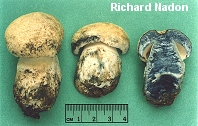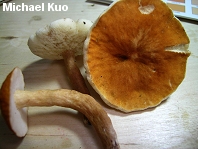The Genus Gyroporus 
[ Basidiomycota > Boletales > Gyroporaceae . . . ]
by Michael Kuo
Gyroporus is a very small genus of boletes whose members are easily recognized by their stems, which are brittle and hollow (at least towards the base in mature specimens) and their yellow spore prints. Like most boletes, they are mycorrhizal. They grow primarily east of the Rocky Mountains, but at least one species, Gyroporus castaneus, is reported in California; a few species range south into Mexico and Central America.
Identification of Gyroporus species as they are currently defined is not difficult, and should not require microscopic analysis of specimens. Cap colors and textures, along with bruising and staining reactions, are the primary identifying features. A key to seven Gyroporus taxa can be found below.
At present (2010) the genus Gyroporus seems to be holding its own in the current onslaught of DNA revelations--but, in a fascinating turn of events, species of Gyroporus appear to be more closely related to earthballs in the genus Scleroderma (together with Pisolithus tinctorius, and Calostoma cinnabarinum) than to most other boletes (except the oddball Gyrodon merulioides). An online Boletales cladogram by Binder and Hibbett (2004) compiles preliminary DNA results for hundreds of boletes; Gyroporus and its close relatives can be found in the Sclerodermatineae group.



